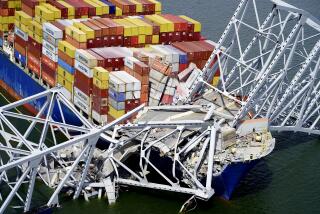An all-or-nothing design
MINNEAPOLIS — A house of cards is how some engineers describe the steel truss system used on the Interstate 35W bridge that collapsed into the Mississippi River, saying that almost any piece of the complex design that failed would have brought down the entire span.
Experts said Thursday that it was far too early to speculate about the specific causes of Wednesday’s bridge collapse, but in the past most bridges over rivers have failed for a handful of known reasons: weak foundations, corrosion, metal fatigue, ship collision or design error.
The bridge, leading into and out of downtown Minneapolis, was being closely watched by transportation officials after studies warned about its deteriorating condition. Six years ago, significant corrosion and cracking were discovered under the roadway, but a top expert in metal fatigue concluded that they did not pose a safety hazard.
The I-35W collapse also occurred during a program to resurface the roadway, another red flag to many experts who theorized that vibrations or unintended disruptions to the truss structure under the roadway could have weakened the bridge so much that it could not bear the load of evening rush-hour traffic.
Catastrophic engineering failures -- whether the crash of a space shuttle or the breach of a levee -- usually result from a large set of problems that become an accepted risk over time and then reach a crucial point that escapes attention.
“We thought we had done all we could,” Dan Dorgan, an engineer for the Minnesota Department of Transportation, said Thursday. “Obviously, something went terribly wrong.”
Thousands of steel truss bridges were built in the interstate highway construction boom of the 1950s and ‘60s because they could support large traffic loads with minimal amounts of steel. Engineers stopped designing them long ago because they require so much labor to build, require a lot of maintenance and were eclipsed by newer technologies.
The I-35W bridge was entirely supported by two main trusses, composed of many small pieces of steel bolted or welded together like a child’s Erector Set. Though it is possible to design a steel truss bridge with redundancy, the I-35W bridge was supported only by those main trusses.
“A truss arch bridge is like a chain -- if you try to take out one link, you lose the whole system,” said Abolhassan Astaneh-Asl, a UC Berkeley professor who is an expert in such bridges. “They are very vulnerable to instability.”
Astaneh compared a steel truss system to a house of cards, which will quickly collapse if one card is pulled out.
The risk was demonstrated in 1967, when a steel truss bridge over the Ohio River collapsed, killing 46 people, said Kent Harries, a civil engineer at the University of Pittsburgh. Not long afterward, an association of highway engineers banned any new bridges that could collapse if a single element failed, so-called nonredundant structures.
The I-35W bridge was completed in 1967, placing it in the last generation before safety rules were upgraded.
The bridge collapse was caught on a surveillance video. It shows the bridge’s 390-foot center span dropping straight down and within seconds the west and east sections buckling and collapsing.
“The real notable thing is the speed and completeness of the collapse,” Harries said.
The collapse most likely was caused by a series of problems that cumulatively weakened the bridge and reduced its ability to carry a heavy load, according to interviews with many engineers.
In 2001, the state’s Department of Transportation grew so worried about the bridge, which carries more traffic than any other span in the state, that it commissioned an extensive engineering study by experts at the University of Minnesota.
The 82-page report discovered cracking and corrosion, but ultimately recommended only that the state step up inspections to every six months, compared with the federal requirement of every two years.
Although the report may have badly missed the mark, it demonstrates the difficulty of assessing cumulative metal fatigue and corrosion, according to Harries. The lead author of the report was one of the nation’s top experts on metal fatigue, he said.
As the nation’s highway system ages, a growing number of bridges are being classified as deficient. A recent U.S. Department of Transportation survey found that 27% of the nation’s bridges are structurally deficient -- the I-35W bridge carried that designation for 17 years.
A number of bridges collapse each year in the United States, though seldom as dramatically as occurred Wednesday.
Of the roughly 500,000 bridges in the nation that span water, about 1,500 collapsed between 1966 and 2005, according to Jean-Louis Briaud, a Texas A&M; University civil engineer and expert in bridge failure. The largest portion of those collapses, about 900, occurred when rivers scoured the foundations of support piers, he said. A few dozen deaths occur each year when bridges collapse.
Briaud would not rule out scour in the I-35W collapse, even though the piers rest on the river banks and the center span covered the entire width of the river. Scour could still have occurred on the banks and caused the piers to slowly tilt over time, he said. The collapse will most likely trigger a renewed examination of the deteriorating U.S. highway system.
The nation’s deficient bridges are part of an estimated $200 billion worth of infrastructure improvements needed across the nation, according to Priscilla Nelson, a civil engineer at the New Jersey Institute of Technology.
“Engineers everywhere feel very sad this happened, but we know in our hearts that it will happen again,” Nelson said. “We need to bite the bullet and make the investments.”
--
nicholas.riccardi@latimes.com
Vartabedian reported from Los Angeles, and Riccardi from Minneapolis.
More to Read
Sign up for Essential California
The most important California stories and recommendations in your inbox every morning.
You may occasionally receive promotional content from the Los Angeles Times.











